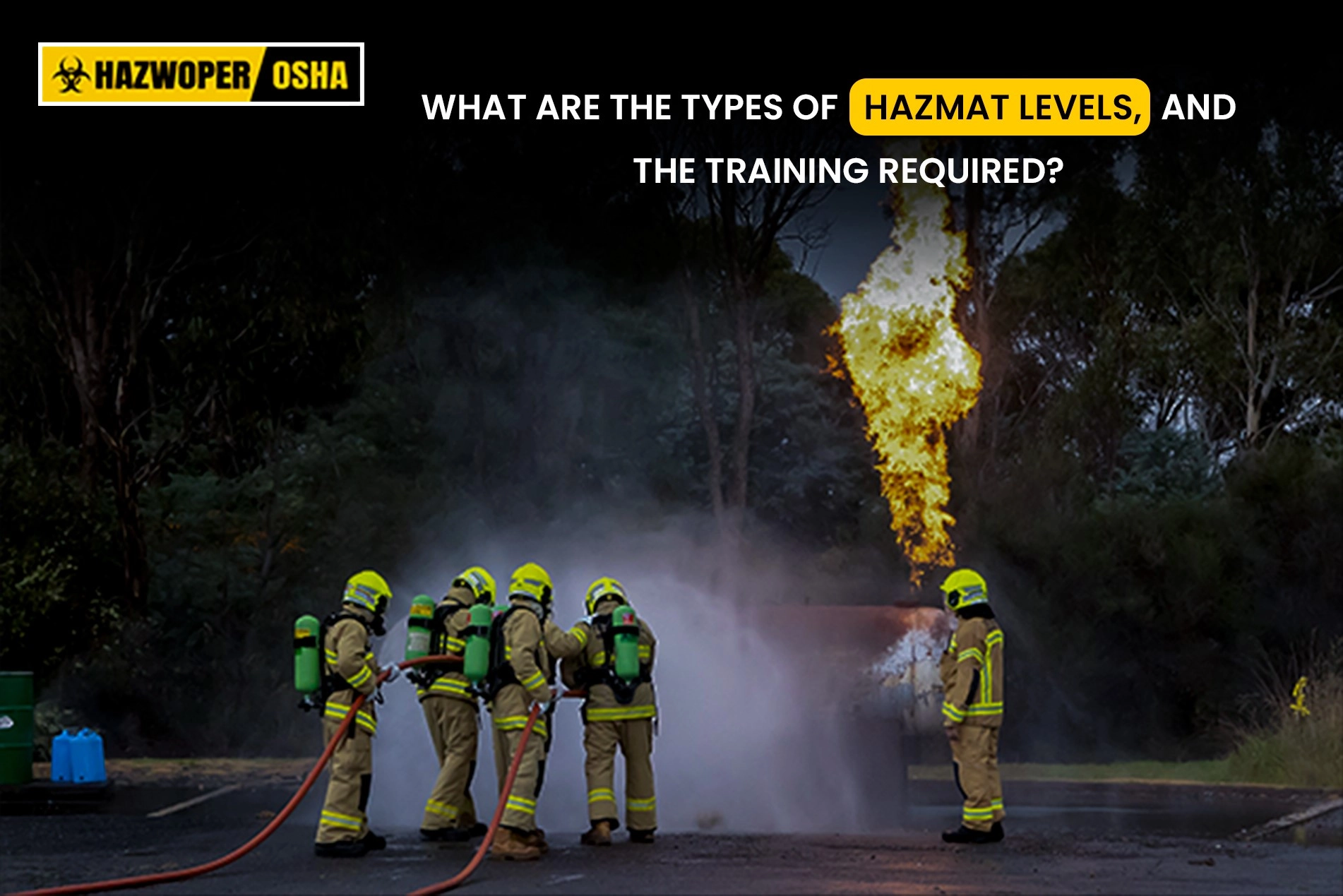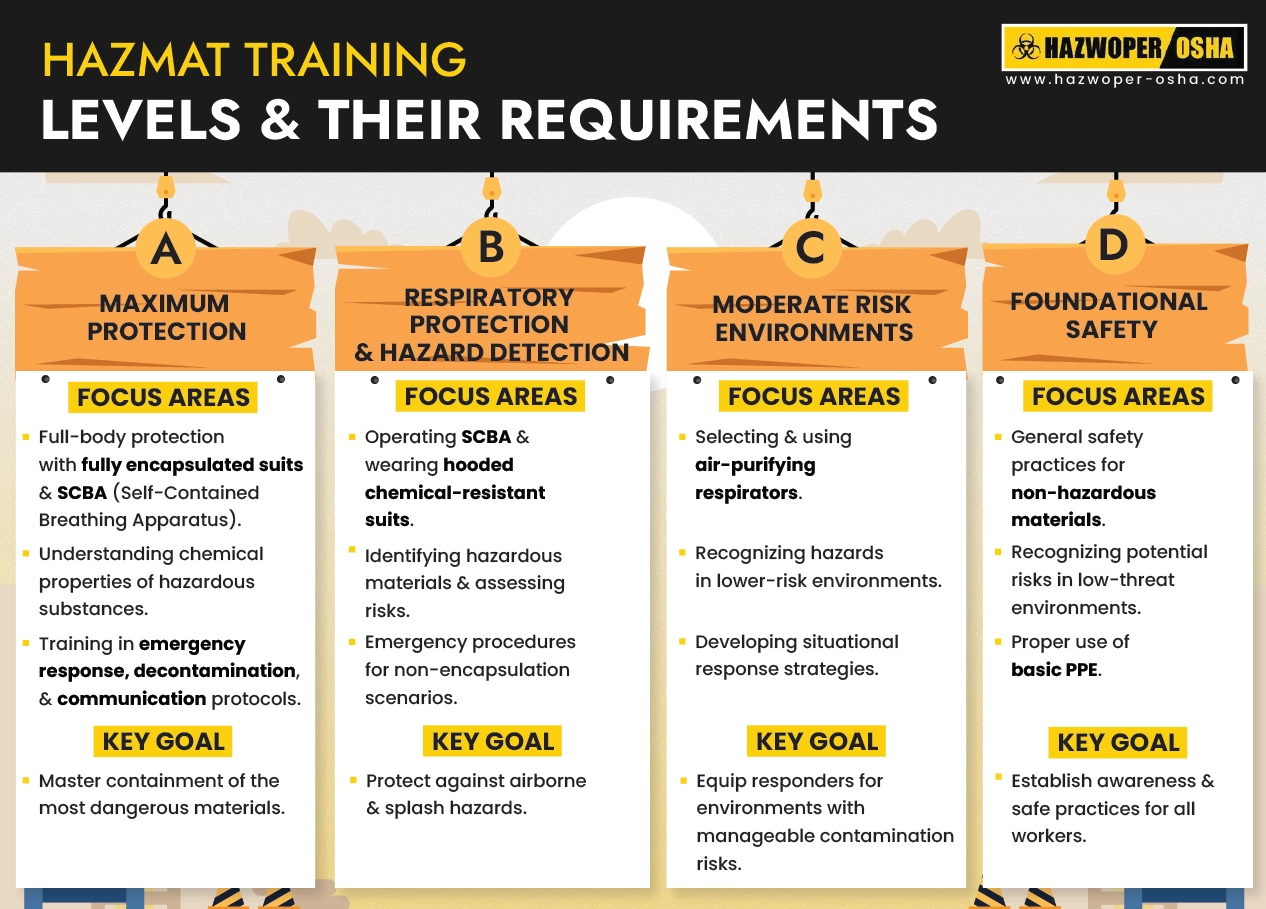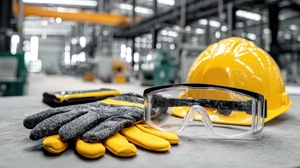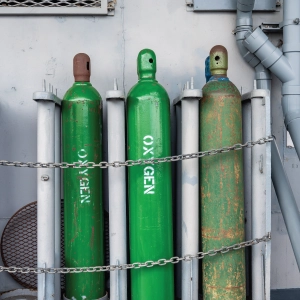What are the types of Hazmat Levels, and the Training Required?

Introduction:
Environmental safety and exposure to dangerous substances can be mitigated by understanding the HAZMAT levels and the training required for each of them. Each level addresses a particular risk among the 4 Hazmat levels, and its response is tailored to provide maximum protection. That is why Hazmat responders should be trained effectively for each level to manage these hazards safely. This blog post will explore the types of Hazmat levels, appropriate Hazmat Responses, and the corresponding training for each to effectively handle the risks associated with each type of hazardous material.
What is Hazmat Training, and Why is It Important?
HazMat training is a significant component of workplace safety, and it educates and upskills employees to handle hazardous materials properly. The different aspects of the HazMat training cover hazard recognition, using personal protective equipment (PPE) properly, and knowing the proper emergency response protocols. With the proper knowledge of the risks associated with hazardous substances, workers can tackle dangerous situations effectively and respond effectively to emergencies. Organizations that deal with hazardous materials should be compliant with OSHA regulations, especially the Hazardous Waste Operations and Emergency Response Standard (HAZWOPER). Sticking to these regulatory requirements helps workplaces prepare for any hazardous incidents. Organizations can deter costly accidents and liabilities with proper HazMat training and protect the safety and health of the employees and the surrounding community.
What are the Different Levels of Hazmat Response?
The Hazmat levels are classified into 4 major categories depending on the hazard's severity and the protection required for them:
-Level A:
It deals with high-risk materials and requires full-body suits.
-Level B:
Materials known to be hazardous but do not need full-body protection, fall under this category. It requires chemical-resistant clothing and SCBA.
-Level C:
This category deals with low-risk hazardous materials and requires protective clothing and respirators.
-Level D:
This level requires basic work clothing for the least risky situations.
For each Hazmat level, we have a detailed blog on the HAZMAT suit types and the level of protection they provide.
The distinct levels of the Hazardous materials (HazMat) response address the particular types of incidents and the associated risks. The five primary levels of the HazMat response cover the following:
1. Awareness Level:
Responders at this level are mostly the first ones to reach the scene. Their training includes the recognition of hazardous materials and initial emergency protocols. They notify the relevant authorities and take the initial actions to mitigate the incident and reduce the exposure and risks to the environment and people.
2. Operations Level:
The responder at this stage defends against the hazard and risk and mitigates the HazMat incidents without entering the Hot Zone. They establish the hazard zones, assist in evacuation, and utilize vapor dispersion and absorption techniques.
3. Technician Level:
The HazMat technicians have a bolder role as they handle known or suspected hazmat releases. Their duties include advanced risk assessments, selecting suitable PPE to safely intervene, and operating the detection equipment.
4. Specialist Level:
The specialists have advanced scientific knowledge regarding HazMat, collaborate with technicians in the HotZone, or offer oversights. Their role is special as they help troubleshoot dangerous situations and effectively manage incidents. They evaluate risks and implement emergency response plans according to the specific incident.
Each level needs tailored training that upskill the responders with the knowledge to manage hazardous materials effectively while keeping everyone safe and involved.
What type of Risk Assessment is Required for Each Level?
Each HazMat level has the appropriate risk assessment level that ensures the responder's safety in the hazardous environment. Following is the risk assessment level for each type of Hazmat response:
Risk Assessment for Level A:
The hazardous substances that are a major threat to the respiratory system, eyes, and skin require this risk assessment. These substances include toxic and carcinogenic materials.
Risk Assessment for Level B:
The hazards are known at this level but do not need full skin protection. These are important during the initial site assessments when liquid splash protection is a must.
Risk Assessment for Level C:
When contaminants have been identified, then this assessment is used. The pollutants are below the permissible exposure limits at this level, requiring less stringent measures.
Risk Assessment for Level D:
This level is used in environments with no known hazards, such as mostly construction sites.
Each HazMat level is calculated by the particular risks related to the hazardous materials present in it. It guides the selection of appropriate PPE to ensure that the responder is safe while managing the possible hazards effectively.
What Types of Hazmat Training are Required for Each Level?
The training requirements for each HazMat level are tailored to the specific risks and protective measures associated with hazardous materials.
Level A
Training Requirements: Personnel at this level undergo comprehensive training that focuses on full-body protection and containment procedures. This includes mastering the use of fully encapsulated suits and SCBA and understanding the chemical properties of substances they may encounter. Training emphasizes emergency response tactics, decontamination processes, and maintaining communication while in protective gear.
Level B
Training Requirements: Level B training centers on respiratory protection and hazard detection. Responders learn to operate SCBAs and hooded chemical-resistant suits, focusing on identifying hazardous materials and assessing risks. This training also covers emergency procedures for situations where hazardous substances are present but do not require full encapsulation.
Level C
Training Requirements: At this level, training primarily focuses on using air-purifying respirators. Responders are instructed to select and properly use these respirators in environments where airborne contaminants are present but at lower risk levels. Additionally, they receive training on hazard recognition and the appropriate response actions based on situational assessments.
Level D
Training Requirements: Level D training involves basic awareness of handling non-hazardous materials. Workers are educated about general safety practices, recognizing potential hazards, and the importance of personal protective equipment (PPE) even in low-risk environments. This foundational training is crucial for ensuring that all personnel can identify risks and respond appropriately, even when working with materials deemed non-hazardous.
Each level of HazMat training is essential for ensuring that responders can effectively manage hazardous situations while prioritizing their safety and that of others.

Who Needs Hazmat Training?
Professionals across different industries need Hazmat training, particularly those who handle, transport, or are exposed to Hazardous materials. The employees in manufacturing, transportation, construction, and emergency response especially need this training. Particularly, personnel transporting and shipping hazardous materials must complete the Department of Transportation (DOT) Hazardous Materials Safety training. In addition, hazardous material awareness training is required for individuals who may witness or discover the release of hazardous substances. The worker from the operational department requires more advanced training related to their responsibilities in hazardous material incident management. All employees exposed to hazardous materials at their workplace must be trained appropriately to stay compliant with the Occupational Safety and Health Administration (OSHA) and minimize the risks to the environment and health. At HAZWOPER OSHA Training, we provide an all-inclusive suite of courses that are compliant with DOT, IATA, and IMDG Hazmat Training, catering to a diverse clientele and available in flexible formats. Enroll today and start learning to be compliant about workplace safety.
Conclusion:
Effective HazMat training is the foundation of workplace safety in hazardous environments especially. Due to this training, the responders and employees acquire the essential knowledge to manage potential risks and protect themselves and others. The crucial steps to develop a safety-first culture include an in-depth understanding of different HazMat protection levels, getting the hang of safety protocols, and staying compliant with the regulations. No matter if the HazMat training is at a basic level or a specialized response, it equips the workers to handle hazardous materials assertively and cut down the chances of accidents.
References:
HazmatNation, June 22, 2021, A guide to the four levels of Hazardous Materials (HazMat) response, https://www.hazmatnation.com/a-guide-to-the-four-levels-of-hazardous-materials-hazmat-response/

 EN |
EN |  ES
ES






























































































































